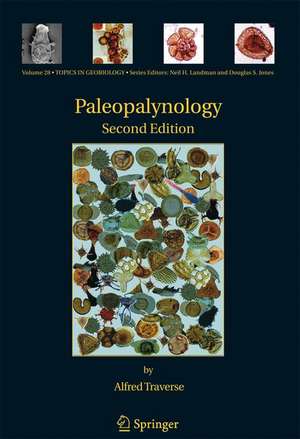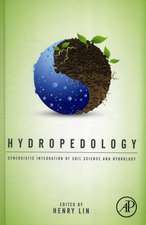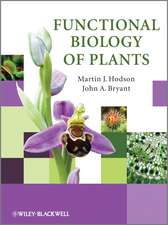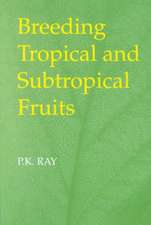Paleopalynology: Second Edition: Topics in Geobiology, cartea 28
Autor Alfred Traverseen Limba Engleză Hardback – 18 mai 2007
Extant spores and pollen are treated first, preparing the student for more difficult work with fossil sporomorphs and other kinds of palynomorphs. Recognizing that palynomorphs occur together in rocks because of chemical robustness and stratigraphic distribution, not biological relationship, the central sections are organized stratigraphically. Among many other topics presented are the sedimentation and geothermal alteration of palynomorphs, and palynofacies analysis. An appendix describes laboratory methods. The glossary, bibliographies and index are useful tools for study of the literature.
| Toate formatele și edițiile | Preț | Express |
|---|---|---|
| Paperback (1) | 1416.12 lei 6-8 săpt. | |
| SPRINGER NETHERLANDS – 27 sep 2007 | 1416.12 lei 6-8 săpt. | |
| Hardback (1) | 1256.41 lei 6-8 săpt. | |
| SPRINGER NETHERLANDS – 18 mai 2007 | 1256.41 lei 6-8 săpt. |
Din seria Topics in Geobiology
- 18%
 Preț: 1858.10 lei
Preț: 1858.10 lei - 20%
 Preț: 822.08 lei
Preț: 822.08 lei - 15%
 Preț: 672.43 lei
Preț: 672.43 lei - 18%
 Preț: 1236.82 lei
Preț: 1236.82 lei - 15%
 Preț: 647.59 lei
Preț: 647.59 lei - 24%
 Preț: 885.02 lei
Preț: 885.02 lei - 18%
 Preț: 951.59 lei
Preț: 951.59 lei - 18%
 Preț: 964.23 lei
Preț: 964.23 lei - 18%
 Preț: 1117.69 lei
Preț: 1117.69 lei - 15%
 Preț: 633.31 lei
Preț: 633.31 lei - 18%
 Preț: 966.27 lei
Preț: 966.27 lei - 18%
 Preț: 952.54 lei
Preț: 952.54 lei - 18%
 Preț: 949.85 lei
Preț: 949.85 lei - 18%
 Preț: 1013.50 lei
Preț: 1013.50 lei - 24%
 Preț: 821.17 lei
Preț: 821.17 lei - 18%
 Preț: 952.40 lei
Preț: 952.40 lei - 18%
 Preț: 961.23 lei
Preț: 961.23 lei - 18%
 Preț: 952.26 lei
Preț: 952.26 lei - 18%
 Preț: 960.42 lei
Preț: 960.42 lei - 18%
 Preț: 1843.11 lei
Preț: 1843.11 lei - 18%
 Preț: 954.31 lei
Preț: 954.31 lei - 18%
 Preț: 959.50 lei
Preț: 959.50 lei - 15%
 Preț: 673.60 lei
Preț: 673.60 lei - 18%
 Preț: 954.14 lei
Preț: 954.14 lei - 15%
 Preț: 640.06 lei
Preț: 640.06 lei - 18%
 Preț: 959.36 lei
Preț: 959.36 lei
Preț: 1256.41 lei
Preț vechi: 1532.20 lei
-18% Nou
Puncte Express: 1885
Preț estimativ în valută:
240.44€ • 250.71$ • 199.83£
240.44€ • 250.71$ • 199.83£
Carte tipărită la comandă
Livrare economică 21 martie-04 aprilie
Preluare comenzi: 021 569.72.76
Specificații
ISBN-13: 9781402056093
ISBN-10: 1402056095
Pagini: 831
Ilustrații: XVIII, 813 p.
Dimensiuni: 155 x 235 x 38 mm
Greutate: 1.56 kg
Ediția:2nd ed. 2007
Editura: SPRINGER NETHERLANDS
Colecția Springer
Seria Topics in Geobiology
Locul publicării:Dordrecht, Netherlands
ISBN-10: 1402056095
Pagini: 831
Ilustrații: XVIII, 813 p.
Dimensiuni: 155 x 235 x 38 mm
Greutate: 1.56 kg
Ediția:2nd ed. 2007
Editura: SPRINGER NETHERLANDS
Colecția Springer
Seria Topics in Geobiology
Locul publicării:Dordrecht, Netherlands
Public țintă
Professional/practitionerCuprins
What Paleopalynology Is and Is Not.- Why One ‘‘Does’’ Paleopalynology and Why It Works.- The Natural History of Palynomorphs.- Spores/Pollen Basic Biology.- Spores/Pollen Morphology.- Stratigraphic Palynology–Precambrian, Cambrian, Ordovician.- Cambrian to Silurian Non-Marine Palynology.- Devonian Palynology.- Carboniferous/Permian Palynology to the End of the ‘‘Paleophytic’’.- Permo-Triassic Palynofloras.- Triassic-Jurassic Palynology.- Triassic-Jurassic Megaspores, Dinoflagellates, Other Microplankton.- Jurassic-Cretaceous Palynology: End of the ‘‘Mesophytic.’’ Advent and Diversification of Angiosperms. Dynamic Evolution of Dinoflagellates.- Paleogene Palynology.- Neogene Palynology.- Holocene Palynology.- Production, Dispersal, Sedimentation and Taphonomy of Spores/Pollen in Relation to the Interpretation of Palynofloras.- Differential Sorting of Palynomorphs into Sediments: Palynofacies, Palynodebris, Discordant Palynomorphs.- Some Factors Affecting Practical Applications of Paleopalynology.
Recenzii
From the reviews of the second edition:
"Paleopalynology, second edition, provides profusely illustrated treatment of fossil palynomorphs, including spores, pollen, dinoflagellate cysts, acritarchs, chitinozoans, scolecodonts, and various microscopic fungal and algal dispersal bodies. The book serves both as a student text and general reference work. Palynomorphs yield information about age, geological and biological environment, climate during deposition, and other significant factors about the enclosing rocks. Extant spores and pollen are treated first, preparing the student for more difficult work with fossil sporomorphs and other kinds of palynomorphs. Recognizing that palynomorphs occur together in rocks because of chemical robustness and stratigraphic distribution, not biological relationship, the central sections are organized stratigraphically. Among many other topics presented are the sedimentation and geothermal alteration of palynomorphs, and palynofacies analysis. An appendix describes laboratory methods. The glossary, bibliographies and index are useful tools for study of the literature." American Association of Stratigraphic Palynologists, Newsletter September 2007, Volume 40, Number 3.
"This book, like the first edition, succeeds admirably and will be a necessary addition to any pollen laboratory. The book could be used as an introductory textbook in a course in geological palynology, but it is also a reference that would be of use in pollen labs or for people needing an introduction to this literature". Review published in EOS, Vol. 89, No. 11, 11 March 2008, written by Konrad Gajewski, Lab. for Paleoclimatology and Climatology, Dept. of Geography, Univ. of Ottowa, Canada.
"Paleopalynology defines this subdiscipline of paleontology in a single concise volume. … The bibliography, glossary, and index are comprehensive, all of which contributes to the utility of thiswork as a stand-alone manual of paleopalynology. … it is possible, with this book in hand, to gain the basics needed to do research on fossil pollen and spores. This work belongs in all libraries that profess to include the natural sciences. Summing Up: Essential. All levels." P. K. Strother, CHOICE, Vol. 45 (8), 2008.
"The book has been thoroughly updated with contemporary references, some new topics, a variety of new ideas, and some old conundrums resolved. … The second edition of Paleopalynology adds new data on the sedimentation and taphonomy of palynomorphs and extracts key concepts from the 1994 volume to give the reader a concise and practical overview … for a variety of geological questions. … an invaluable reference for working scientists and a comprehensive text for students. … Certainly this is an invaluable scientific contribution.", Nan Crystal Arens, American Paleontologist, Vol. 17 (1), Spring 2009.
"This book is a valuable asset to paleopalynology and highlights its importance as a microplaleontological discipline. … This book will serve as a useful reference for palynologists and nonpalynologists, and for professionals and students … .", Francisca E. Oboh-Ikuenobe, Palaios Society for Sedimentary Geology, June, 2009.
"Paleopalynology, second edition, provides profusely illustrated treatment of fossil palynomorphs, including spores, pollen, dinoflagellate cysts, acritarchs, chitinozoans, scolecodonts, and various microscopic fungal and algal dispersal bodies. The book serves both as a student text and general reference work. Palynomorphs yield information about age, geological and biological environment, climate during deposition, and other significant factors about the enclosing rocks. Extant spores and pollen are treated first, preparing the student for more difficult work with fossil sporomorphs and other kinds of palynomorphs. Recognizing that palynomorphs occur together in rocks because of chemical robustness and stratigraphic distribution, not biological relationship, the central sections are organized stratigraphically. Among many other topics presented are the sedimentation and geothermal alteration of palynomorphs, and palynofacies analysis. An appendix describes laboratory methods. The glossary, bibliographies and index are useful tools for study of the literature." American Association of Stratigraphic Palynologists, Newsletter September 2007, Volume 40, Number 3.
"This book, like the first edition, succeeds admirably and will be a necessary addition to any pollen laboratory. The book could be used as an introductory textbook in a course in geological palynology, but it is also a reference that would be of use in pollen labs or for people needing an introduction to this literature". Review published in EOS, Vol. 89, No. 11, 11 March 2008, written by Konrad Gajewski, Lab. for Paleoclimatology and Climatology, Dept. of Geography, Univ. of Ottowa, Canada.
"Paleopalynology defines this subdiscipline of paleontology in a single concise volume. … The bibliography, glossary, and index are comprehensive, all of which contributes to the utility of thiswork as a stand-alone manual of paleopalynology. … it is possible, with this book in hand, to gain the basics needed to do research on fossil pollen and spores. This work belongs in all libraries that profess to include the natural sciences. Summing Up: Essential. All levels." P. K. Strother, CHOICE, Vol. 45 (8), 2008.
"The book has been thoroughly updated with contemporary references, some new topics, a variety of new ideas, and some old conundrums resolved. … The second edition of Paleopalynology adds new data on the sedimentation and taphonomy of palynomorphs and extracts key concepts from the 1994 volume to give the reader a concise and practical overview … for a variety of geological questions. … an invaluable reference for working scientists and a comprehensive text for students. … Certainly this is an invaluable scientific contribution.", Nan Crystal Arens, American Paleontologist, Vol. 17 (1), Spring 2009.
"This book is a valuable asset to paleopalynology and highlights its importance as a microplaleontological discipline. … This book will serve as a useful reference for palynologists and nonpalynologists, and for professionals and students … .", Francisca E. Oboh-Ikuenobe, Palaios Society for Sedimentary Geology, June, 2009.
Notă biografică
Alfred Traverse first encountered palynology, then a smaller subject called ‘pollen analysis’, in courses at Cambridge University under Harry Godwin and others, in 1946-47. At Harvard University he did a Ph. D. dissertation with E. S. Barghoorn on a mid-Cenozoic palynoflora, it was in 1951 the first doctoral dissertation on paleopalynology in the USA. He then worked as a coal technologist and palynologist for the U.S. Bureau of Mines and Shell Oil Company, 1951-1965, and became Assistant Professor of Palynology at Pennsylvania State University, 1966-92. He was guest professor of palynology at the Swiss Federal Technical Institute, 1980-81, and at the Senckenberg Museum, Frankfurt, Germany, 1991-92. He is now Emeritus Professor Palynology at Penn State, and continues to do research in the field. His publications in palynology cover all geological periods from Ordovician to present, and many of the kinds of palynomorphs, as well a such contributions to general palynological topics as the books, Paleopalynology (1st Ed., Unwin-Hyman, 1988), and Sedimentation of Organic Particles (Cambridge Univ. Press, 1994). He was for some years Editor of the Catalog of Fossil Spores and Pollen, and remains keenly interested in nomenclature and systematics of fossil palynomorphs.
Caracteristici
Provides a very complete coverage of all aspects of the study of all of the kinds of fossil palymorphs as yet studied Second edition closely follows the first edition per request by a great variety of users and has been updated and expanded where necessary The gradual introduction of concepts, and the stratigraphic organization of presentation make the volume not only suitable as a reference source, but also as a teaching source
Descriere
Descriere de la o altă ediție sau format:
This book provides complete coverage of all aspects of the study of all fossil palynomorphs yet studied. It is a profusely illustrated treatment. The book serves both as a student text and general reference work. Palynomorphs yield information about age, geological and biological environment, climate during deposition, and other significant factors about the enclosing rocks. Extant spores and pollen are treated first, preparing the student for more difficult work with fossil sporomorphs and other kinds of palynomorphs. An appendix describes laboratory methods. The glossary, bibliographies and index are useful tools for study of the literature.
This book provides complete coverage of all aspects of the study of all fossil palynomorphs yet studied. It is a profusely illustrated treatment. The book serves both as a student text and general reference work. Palynomorphs yield information about age, geological and biological environment, climate during deposition, and other significant factors about the enclosing rocks. Extant spores and pollen are treated first, preparing the student for more difficult work with fossil sporomorphs and other kinds of palynomorphs. An appendix describes laboratory methods. The glossary, bibliographies and index are useful tools for study of the literature.








